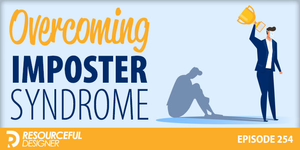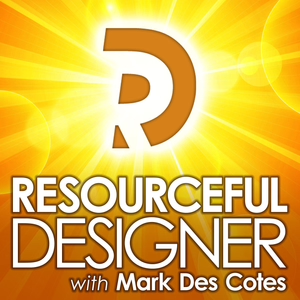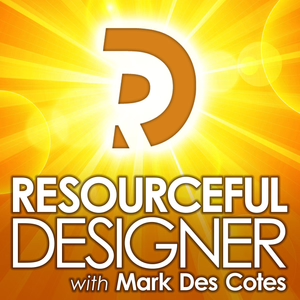
Overcoming Imposter Syndrome - RD254
04/05/21 • 20 min
I don’t know if it’s the pandemic, the stress of everything we’ve had to endure over the past year. But lately, I’ve seen more and more designers struggling with Imposter Syndrome. I’ve seen it in the Resourceful Designer Community. In Facebook groups. And just talking with people, I know in the design space.
I don’t know what’s causing so many people in our profession to doubt themselves and their abilities. But if you’re one of them, let me tell you a little secret that may make you feel better. Although everyone feels Imposter Syndrome at one time or another. It’s most often felt by high achievers who have trouble celebrating their success, no matter how large or small. So if you suffer from Imposter Syndrome, there’s a good chance you’re a high achiever. That’s a good thing and something that should make you feel a bit better.
In case you are unfamiliar with the term Imposter Syndrome, it refers to an internal experience of believing that you are not as competent as others perceive you to be. In other words, you don’t think you’re as good as other people think you are.
Imposter Syndrome An internal experience of believing that you are not as competent as others perceive you to beI suffer from Imposter Syndrome when it comes to illustrations. If you’re a long-time follower of Resourceful Designer, you’ve heard me on several occasions say that I am not an illustrator. And yet, the truth is, I can draw. I’ve been drawing my whole life. Maybe not regularly; I haven’t honed my skills, but it’s not like I’ve never doodled before with some degree of success. And I’ve had many people over the years tell me I’m good at it. But in my mind, I’m not.
I look at what others like Andrew or Kat, or Krista from the Resourceful Designer Community can do, and my skills pale compared to theirs. In my mind, the only reason people tell me I’m good at illustrating is that they don’t want to make me feel bad by telling me the truth. That’s Imposter Syndrome.
And you know what? In this case, it’s ok. It’s ok because I’ve never wanted to be an illustrator. So if I don’t think I’m good enough, so be it. I’m ok with that. But that’s not the issue I’ve seen lately among fellow designers.
Imposter Syndrome becomes serious when it involves what you are trying to do to earn a living. What I’m seeing is a lot are people with the skills, talent and knowledge to do something well but who feel they are not good enough to be compensated for what they’re offering. People who are competent web designers but don’t think they’re good enough to charge $5,000 or $10,000 or even $50,000 for a website. Or people who are talented logo designers who have never charged more than a couple of hundred dollars for a logo project. That’s Imposter Syndrome.
These people have this idea in their head that if they charge that much, others will think they’re a fraud, and they’ll be exposed. These people are afraid to approach clients they really want to work with because they don’t think they’re good enough to work with them.
Is that how you feel? Are you unable to internalize your success because you’re afraid of being outed as an unqualified fraud?
Let me tell you something. You are not alone. In fact, everyone battles imposter syndrome at one point or another—even those who seem to have it all.
Actors Tena Fey, Emma Watson and Tom Hanks have all said in interviews that no matter how well they do, they always feel inadequate and that at any moment, someone’s going to find out they are not good actors and don’t deserve the success they’ve achieved.
Best-selling author John Green, who’s won several literary awards and whose books have been turned into major motion pictures, says he feels like a fraud all the time. He’s said that he doesn’t feel like he knows how to write a novel and doesn’t think he ever will. He finds pleasure in the process of writing, but he thinks everything he writes sucks.
If talented, successful people such as this suffer from imposter syndrome, what chance do you have? The truth is, you have as much chance as them and as everyone else.
To overcome that feeling, you have to realize that everything you’ve done in your life so far, every achievement you’ve achieved, no matter how small, was something you were not qualified to do before you actually did it. You weren’t able to walk - until you did. You weren’t able to ride a bike - until you did. You weren’t able to use the software you use daily - until you did. You weren’t able to complete a design job for a client - until you did.
You are the person you are today because you’ve successfully achieved thousands, if not millions, of things ...
I don’t know if it’s the pandemic, the stress of everything we’ve had to endure over the past year. But lately, I’ve seen more and more designers struggling with Imposter Syndrome. I’ve seen it in the Resourceful Designer Community. In Facebook groups. And just talking with people, I know in the design space.
I don’t know what’s causing so many people in our profession to doubt themselves and their abilities. But if you’re one of them, let me tell you a little secret that may make you feel better. Although everyone feels Imposter Syndrome at one time or another. It’s most often felt by high achievers who have trouble celebrating their success, no matter how large or small. So if you suffer from Imposter Syndrome, there’s a good chance you’re a high achiever. That’s a good thing and something that should make you feel a bit better.
In case you are unfamiliar with the term Imposter Syndrome, it refers to an internal experience of believing that you are not as competent as others perceive you to be. In other words, you don’t think you’re as good as other people think you are.
Imposter Syndrome An internal experience of believing that you are not as competent as others perceive you to beI suffer from Imposter Syndrome when it comes to illustrations. If you’re a long-time follower of Resourceful Designer, you’ve heard me on several occasions say that I am not an illustrator. And yet, the truth is, I can draw. I’ve been drawing my whole life. Maybe not regularly; I haven’t honed my skills, but it’s not like I’ve never doodled before with some degree of success. And I’ve had many people over the years tell me I’m good at it. But in my mind, I’m not.
I look at what others like Andrew or Kat, or Krista from the Resourceful Designer Community can do, and my skills pale compared to theirs. In my mind, the only reason people tell me I’m good at illustrating is that they don’t want to make me feel bad by telling me the truth. That’s Imposter Syndrome.
And you know what? In this case, it’s ok. It’s ok because I’ve never wanted to be an illustrator. So if I don’t think I’m good enough, so be it. I’m ok with that. But that’s not the issue I’ve seen lately among fellow designers.
Imposter Syndrome becomes serious when it involves what you are trying to do to earn a living. What I’m seeing is a lot are people with the skills, talent and knowledge to do something well but who feel they are not good enough to be compensated for what they’re offering. People who are competent web designers but don’t think they’re good enough to charge $5,000 or $10,000 or even $50,000 for a website. Or people who are talented logo designers who have never charged more than a couple of hundred dollars for a logo project. That’s Imposter Syndrome.
These people have this idea in their head that if they charge that much, others will think they’re a fraud, and they’ll be exposed. These people are afraid to approach clients they really want to work with because they don’t think they’re good enough to work with them.
Is that how you feel? Are you unable to internalize your success because you’re afraid of being outed as an unqualified fraud?
Let me tell you something. You are not alone. In fact, everyone battles imposter syndrome at one point or another—even those who seem to have it all.
Actors Tena Fey, Emma Watson and Tom Hanks have all said in interviews that no matter how well they do, they always feel inadequate and that at any moment, someone’s going to find out they are not good actors and don’t deserve the success they’ve achieved.
Best-selling author John Green, who’s won several literary awards and whose books have been turned into major motion pictures, says he feels like a fraud all the time. He’s said that he doesn’t feel like he knows how to write a novel and doesn’t think he ever will. He finds pleasure in the process of writing, but he thinks everything he writes sucks.
If talented, successful people such as this suffer from imposter syndrome, what chance do you have? The truth is, you have as much chance as them and as everyone else.
To overcome that feeling, you have to realize that everything you’ve done in your life so far, every achievement you’ve achieved, no matter how small, was something you were not qualified to do before you actually did it. You weren’t able to walk - until you did. You weren’t able to ride a bike - until you did. You weren’t able to use the software you use daily - until you did. You weren’t able to complete a design job for a client - until you did.
You are the person you are today because you’ve successfully achieved thousands, if not millions, of things ...
Previous Episode

No episode this week of March 27, 2021
Next Episode

Why You Should Pitch Retainer Agreements - RD255
Do you pitch retainer agreements to your clients?
In the Resourceful Designer Community Slack group, we have a channel called #Bragging-Rights. It’s a place where community members share their most recent wins. Things like Katie telling us her client approved the logo she asked us to critique a few weeks ago. Or Brian sharing the completion of a huge website project with an extremely tight deadline. Or Mike sharing yet another signed design proposal.
Whether it’s landing a new client or having their design business showcased in a magazine, everyone in the Community is genuinely happy for the person sharing the good news. That’s what being part of a community is.
But nothing seems to garner more congratulations than when someone says they’ve landed a new retainer client. We don’t even have to know the details. The fact that it’s a retainer client is huge and worth celebrating on its own.
You see, having a client on retainer is considered the pinnacle of client acquisition.
What is a retainer agreement?So what does having a client on retainer mean?
- It means guaranteed work.
- It means guaranteed income.
- It means a fixed schedule.
- And most importantly, it means better clients that you can create long-lasting relationships.
A retainer means your client pays you in advance, regularly, in exchange for whatever work you outlined in the retainer agreement.
You see. One of the drawbacks of being a freelance designer is the unpredictability of income. You don’t work a 9-5 at a set hourly rate. Nor are you working in a salaried position with a guaranteed income. There’s no predictable paycheck arriving on a fixed schedule. That’s one of the sacrifices we home-based designers make for the freedom of working for ourselves.
But a retainer brings us closer to that predictable, guaranteed income. It creates a steady cash flow you can count on. This is great since you know how much money you are guaranteed every month, which helps with monthly expenses.
Not only that. But a retainer helps provide both stability and consistency in your work instead of learning how to deal with new clients every project. It reduces the need to pitch and win new design projects constantly.
On top of all that, Retainer agreements attract better clients and allow you to build a deeper relationship with them. Plus, clients treat designers they have on retainer with more respect and as an expert and professional.
These clients understand the long-term benefit of working with you. They are not looking for the least expensive designer. No, they’re looking for someone who can consistently contribute to their business. They want an expert and are willing to invest in one.
Another benefit of retainers is your schedule. In most cases, you know in advance how much work you will have from your retainer clients every month. This makes it much easier to plan your schedule. If you’re contracted to create a weekly blog post image and want to take a two-week vacation. You know in advance that you need to create three images the week before you leave.
Knowing your schedule in advance allows you to manipulate it when needed.
How does a retainer work?A retainer is a contract between you and a client that states the service or deliverable you will provide them regularly in exchange for how much.
Most retainer agreements work monthly. A client pays you a fixed fee every month in exchange for what you provide to them.
You can also have a yearly retainer payment where the client agrees to pay for the full year in advance. Or a lump-sum payment where the client pays you a certain amount, and you work it off or supply deliverables until the money runs out, at which time the agreement is ended or starts over.
Retainer benefits to the clientWhy are retainer agreements appealing to clients? Oftentimes, retainers have built-in discounts that make them more appealing for the client.
For example: If your rate is $100/hour, you might offer a retainer of $900 for 10 hours of work each month. Your client saves $100 each month, and you sacrifice $10/hour in exchange for the guarantee of payment.
If you don’t charge by the hour, you can set up retainers for deliverables.
For example, you agree to create four blog post images and 16 social media images every month for a fixed rate of, let’s say, $500 per month. The client can then budget $500 every month knowing you will deliver the images. It gives them peace of mind knowing it’s taken care of.
How do you pitch a retainer to a client?The idea of pitching a retainer to a client can seem scary if you’re not used to it, especially if the client came to you with only one proj...
If you like this episode you’ll love

Resourceful Designer: Strategies for running a graphic design business

Joomla Beat Podcast | Web design, development, online marketing, social media & website management

Entrepreneurs on Fire

Shailey & Katie's Lemonade Stand: Design Moms Finding the Happy Balance as Work-from-home Entrepreneurs

The Portrait System Podcast
Episode Comments
Generate a badge
Get a badge for your website that links back to this episode
<a href="https://goodpods.com/podcasts/resourceful-designer-strategies-for-running-a-graphic-design-business-1053/overcoming-imposter-syndrome-rd254-12791433"> <img src="https://storage.googleapis.com/goodpods-images-bucket/badges/generic-badge-1.svg" alt="listen to overcoming imposter syndrome - rd254 on goodpods" style="width: 225px" /> </a>
Copy